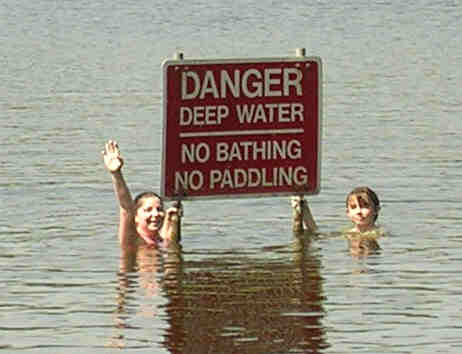|
WILD SWIMMING - THE LEGAL SIDE 
 |
|
|
The right to swim is a complex issue which, in many cases, is undetermined. This page can
only offer general guidelines which do not apply to every situation. Our advice is to check
with the locals before taking the plunge in an unknown water. This always makes good sense
since there may be safety issues to consider. The following only applies to England and Wales. With parts of the Land Reform (Scotland) Act 2003 coming into effect recently, there are much wider rights of access to water in Scotland. More on that soon. RIVERS You have a right to 'navigate' (not 'swim') in most, but not all, tidal waters. There may be local bylaws prohibiting swimming in certain tidal waters for a variety of reasons. Swimming may be allowed in many stretches of rivers which are not tidal where there is an established historic use by the public or an Act of Parliament establishing public navigation rights. If anyone can sail a boat in a river as of right without having to obtain permission (or belong to a club) there are public navigation rights over the water which means that you are probably (but, again, not always) allowed to swim. Unlike many other countries the owners of the bank in the UK own half the river bed and, unless there is an established use, a swimmer could be trespassing. Land owners are not likely to bother you swimming (unless they lease out the water for other activities) but may object to you trespassing on their land when getting in. Find a public access point (often a public footpath or a road). Stay clear of private, non tidal, fishing waters (or private waters used for other activities) - those engaged in these activities have a right to ask you to leave. The Environment Agency (EA) which is responsible for a range of issues concerning rivers only put No Swimming signs at particularly dangerous spots. British Waterways do not allow swimming in its canals and rivers used for navigation. LAKES Here again, there are many lakes in which the public has established historic navigation rights. These waters may or may not be registered as Common Land and you may not have a right to swim in those which are - the 'Rights of Common' may be fishing for example. The owner of a lake in which people have been swimming for many years may dispute their right to do so but he will probably have to take out a court injunction in order to stop them. Equally, you will have to go to court (or go through the lengthy process of registering the water as a 'Village Green') in order to establish swimming rights. Attitudes towards lake swimming in the countryside varies from county to county. Land owners may tolerate you swimming in their lake (unless the water is used for other leisure activities) but could make it difficult for you to gain access to the water. You obviously have to keep out of fenced areas. If caught trespassing simply leave peacefully. Trespassing is a civil matter but the police can be called under certain circumstances. For details see the Trespassing page. The situation in lakes and ponds near centres of population are more complex. The number of traditional bathing waters within country parks in some parts of the country is diminishing at an alarming rate allegedly because of health and safety considerations. Man-made ponds are more at risk of being closed to swimmers than natural ones. There used to be a great deal of confusion over legal arguments used to justify these closures To make matters worse, a number of organisations with no statutory powers have jumped on the band-wagon of confusion and acquired unacceptable power over the fate of traditional bathing waters. All this has changed following latest court rulings (April 2005). See the Occupier's Liability and HSE pages for details. RESERVOIRS Swimming is not allowed in most reservoirs. |
|
 No Swimming warning signs are, at times meaningless. This one, is in a lake which is as safe as they come and where there are public navigation rights |
|
|
Would you like to add to or comment on the information given in this article? Please click here to email us Thanks. |
|

